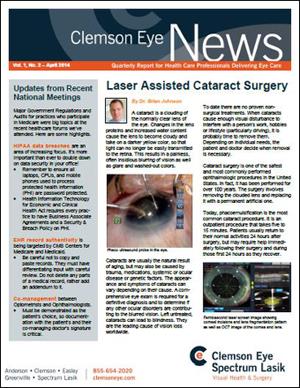Posted by: Clemson Eye in News

Click here to view and download the Laser Assisted Cataract Surgery PDF
A cataract is a clouding of the normally clear lens of the eye. Changes in the lens proteins and increased water content cause the lens to become cloudy and take on a darker yellow color, so that light can no longer be easily transmitted to the retina. This results in a painless, often insidious blurring of vision as well as glare and washed-out colors.
Cataracts are usually the natural result of aging, but may also be caused by trauma, medications, systemic or ocular disease or genetic factors. The appear-ance and symptoms of cataracts can vary depending on their cause. A com-prehensive eye exam is required for a definitive diagnosis and to determine if any other ocular disorders are contribu-ting to the blurred vision. Left untreated, cataracts can lead to blindness. They are the leading cause of vision loss worldwide.
To date there are no proven non-surgical treatments. When cataracts cause enough visual disturbance to interfere with a person’s work, hobbies or lifestyle (particularly driving), it is probably time to remove them. Depending on individual needs, the patient and doctor decide when removal is necessary.
Cataract surgery is one of the safest and most commonly performed ophthalmologic procedures in the United States. In fact, it has been performed for over 100 years. The surgery involves removing the clouded lens and replacing it with a permanent artificial one.
Today, phacoemulsification is the most common cataract procedure. It is an outpatient procedure that takes five to 15 minutes. Patients usually return to their normal activities 24 hours after surgery, but may require help immedi-ately following their surgery and during those first 24 hours as they recover.
During phacoemulsification, the surgeon puts drops in the eye to dilate the pupil and topical anesthetic drops to numb the eye. He or she makes a tiny manual incision in the cornea and inserts a small probe that vibrates with high-frequency ultrasound (sound waves) to break the cataract into tiny pieces and removes them through a central aspiration port. After the ultrasound probe is removed, a new probe is inserted to suck out any remaining lens particles. The surgeon then inserts a small foldable acrylic lens through the incision in the cornea. The lens slowly unfolds in the eye and is gently maneuvered into position.
Today, patients can chose the intraocular lens (IOL) that best suits their life-style. For instance, a multifocal IOL, like the ReSTOR® lens, provides a range of vision. A full 85% of Clemson Eye patients never wear glasses again after their ReSTOR® lens implant.4
Along with improved IOL technology, cataract surgery has advanced to include the femtosecond laser. The benefits to patients are substantial.
Laser Assisted Cataract Surgery
Approved for use in cataract surgery by the FDA in 2010, and introduced in 2011, the femtosecond laser is now used by a small number of select surgeons to assist or replace several aspects of manual cataract surgery. It is used to make the initial incisions in the cornea, to create the capsulotomy, to soften and break up the clouded lens, and to make incisions within the peripheral cornea to correct pre-existing astigmatism.
The patient benefits include more reproducibly consistent and stable incisions, which facilitate faster healing, are more secure and have less risk of leaks and infection.1 The femtosecond laser is also able to create a near perfect, round opening in the anterior capsule.2 This has several benefits over a manually created capsulotomy. The primary benefit is the ability to recreate the exact same size capsule opening every single time, which improves the estimation of the final position of the lens implant in the eye – the Effective Lens Position (ELP). This improves the surgeon’s ability to accurately calculate lens implant power.
Also, the ability to perform the capsulorhexis (removing part of the capsule that the lens sits inside) in a con-trolled fashion before making an incision into the eye adds a margin of safety, especially in higher risk cases such as traumatic cataracts, mature white lenses, and in pseudo-exfoliation. Using the invisible light of the femtosecond laser to help break up the cataract decreases the amount of ultrasound energy and ultrasound time required for the procedure. This causes less stress and collateral damage to eye tissue,3 particularly the corneal endo-thelium, allowing more rapid healing and better visual acuity post-surgery.
In addition, the femtosecond laser is used to create corneal relaxing incisions to correct pre-existing astigmatism. The precision of the laser-created incisions gives us greater control over the refract-tive correction, leading to improved visual outcomes.4
These laser-created incisions combined with advanced technology IOLs, which include multi-focal and astigmatism-correcting lenses, mean many cataract patients no longer require glasses or are considerably less dependent on them after their Laser Assisted Cataract Surgery (LACS), regardless of their age. According to recent data from Market Scope, 5.3% of cataract patients in the United States had LACS in 2013.
The use of femtosecond lasers and advanced IOLs are exciting develop-ments. They offer a safer, more accurate outcome for cataract patients. The surgeons at Clemson Eye were among the first in the country to perform Laser Assisted Cataract Surgery with advanced IOLs. We use the most advanced suite of laser-guided surgery systems available today.
Dr. Brian Johnson is a Clemson Eye ophthalmologist specializing in cataract surgery and comprehensive medical eye care
1. Nagy Z, Takacs A, Filkorn T, Sarayba M. Initial clinical evaluation of an intraocular femtosecond laser in cataract surgery. J Refract Surg. 2009; 25(12):1053-1060.
2. Palanker DV, Blumenkranz MS, Andersen D, et al. Femtosecond laser-assisted cataract surgery with integrated optical coherence tomography. Sci Transl Med 2010; 2:58ra85.
3. “Laser Pretreatment Softens Cataracts, Allows for Safer, Easier Removal, Researchers Say”, Charlene Laino, WebMD Health News, (Reviewed by Laura J. Martin, MD), Oct. 25, 2011.
4. Clemson Eye Laser Cataract with Advanced Intraocular Lens Replacement Results, 2013.